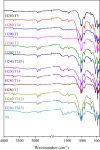Combustion Behavior of Sewage Sludge Hydrochar Obtained in Fast Hydrothermal Carbonization
- PMID: 40547672
- PMCID: PMC12177602
- DOI: 10.1021/acsomega.5c00963
Combustion Behavior of Sewage Sludge Hydrochar Obtained in Fast Hydrothermal Carbonization
Abstract
Sewage sludge (SS) is a complex biomass with a high content of inorganic and organic matter. The hydrothermal carbonization process (HTC) was used to produce a carbonaceous material with energy densification derived from SS. For this, temperatures of 200, 240, and 280 °C, reaction times of 30, 75, and 120 min, without or with H2SO4 acid addition (0.5 and 1% v/v) were assessed in the SS HTC process. Hydrochars (HC) were characterized by FTIR spectroscopy and CHNS elemental and thermogravimetric analyses. The energetic evaluation was performed by a higher heating value (HHV) estimation. HC presented yields ranging from 44.4 to 57.8% with a high content of organic matter and ashes due to the composition of SS. The H/C and O/C atomic ratios, ranging from 0.93 to 1.93 and 0.12 to 0.39, respectively, indicated the carbonization of SS due to dehydration and decarboxylation reactions, resulting in a carbonaceous material. FTIR analysis indicates the presence of different organic groups (i.e., O-H, C-H, CC, and CO), as well as inorganic ones (Si-O). HHV of HC ranged from 13.4 to 16.5 MJ kg-1 with energy densification from 0.9 to 1.1, indicating a similar energy content of HC and SS. However, energy yield efficiency ranged from 38.2 to 57.2%, being correlated with temperature and time in both acidic conditions. Combustion behavior of HC indicates that higher thermal stabilization was provided with the increase of temperature, time, and sulfuric acid.
© 2025 The Authors. Published by American Chemical Society.
Figures
Similar articles
-
Combustion reactivity of hydrothermally derived biochar from sugarcane green harvesting residues (GHR): An evaluation as a solid fuel.Bioresour Technol. 2025 Oct;434:132843. doi: 10.1016/j.biortech.2025.132843. Epub 2025 Jun 17. Bioresour Technol. 2025. PMID: 40554016
-
Hydrothermal Carbonization of Microalgae Biomass from Wastewater Treatment: Effects of Acid Pretreatment.ACS Omega. 2025 Jul 21;10(30):33138-33148. doi: 10.1021/acsomega.5c02582. eCollection 2025 Aug 5. ACS Omega. 2025. PMID: 40787395 Free PMC article.
-
A rapid and systematic review of the clinical effectiveness and cost-effectiveness of topotecan for ovarian cancer.Health Technol Assess. 2001;5(28):1-110. doi: 10.3310/hta5280. Health Technol Assess. 2001. PMID: 11701100
-
Electronic cigarettes for smoking cessation.Cochrane Database Syst Rev. 2022 Nov 17;11(11):CD010216. doi: 10.1002/14651858.CD010216.pub7. Cochrane Database Syst Rev. 2022. Update in: Cochrane Database Syst Rev. 2024 Jan 8;1:CD010216. doi: 10.1002/14651858.CD010216.pub8. PMID: 36384212 Free PMC article. Updated.
-
Electronic cigarettes for smoking cessation.Cochrane Database Syst Rev. 2021 Sep 14;9(9):CD010216. doi: 10.1002/14651858.CD010216.pub6. Cochrane Database Syst Rev. 2021. Update in: Cochrane Database Syst Rev. 2022 Nov 17;11:CD010216. doi: 10.1002/14651858.CD010216.pub7. PMID: 34519354 Free PMC article. Updated.
References
-
- United Nations Transforming our world: the 2030 Agenda for Sustainable Development | Department of Economic and Social Affairs. https://sdgs.un.org/2030agenda (accessed 2025–01–09).
-
- Jones E. R., Van Vliet M. T. H., Qadir M., Bierkens M. F. P.. Country-Level and Gridded Estimates of Wastewater Production, Collection, Treatment and Reuse. Earth Syst. Sci. Data. 2021;13(2):237–254. doi: 10.5194/essd-13-237-2021. - DOI
-
- Liqa, R.-S. ; Jayakody, P. . Drivers and Characteristics of Wastewater Agriculture in Developing Countries: Results from a Global Assessment; IWMI; 2008.
-
- World Health Organization Water Sanitation and Health. https://www.who.int/teams/environment-climate-change-and-health/water-sa... (accessed 2025–01–09).
LinkOut - more resources
Full Text Sources


